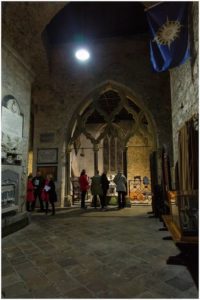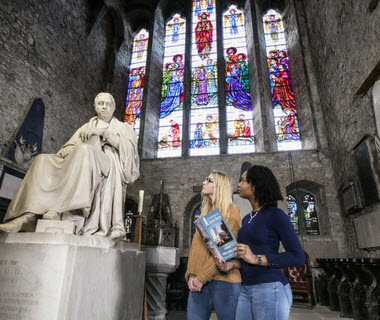Saint Mary’s Cathedral is believed to have been built on the site of a Viking thingmote (meeting place), and later the palace of the O’Brien kings of Thomond. It is an extraordinary building that has been ever-present during invasions, sieges, battles, wars, famines and times of peace. It is also a treasure of Irish religious art.
Here are some of the Cathedral’s century old features not to be missed:
The Chapels
There are 6 chapels within the cathedral – the Chapel of Saint James &Mary Magdalen; the Lady Chapel; the Chapel of the Holy Spirit; the Jebb Chapel; the O’Brien Chapel; and the Glentworth Chapel
The Original Altar in the Lady Chapel
The altar in Lady Chapel is 4 metres long (13 ft), weighs three tons and is the cathedral’s original, pre-Reformation High Altar. In 1651, after Oliver Cromwell captured Limerick, his parliamentary army used the cathedral as a stable – a fate suffered by other cathedrals during the Cromwellian campaign in Ireland. His troops also removed the altar and dumped it. But it was recovered in the 1960s and was reinstated.
The Famous Misericords
One of the most famous features in Saint Mary’s are the carved misericords. These misericords are unique in Ireland and are the only surviving pre-Elizabethan carvings. They probably date from 1480-1500, perhaps from the restoration work carried out by the last pre-Reformation Bishop of Limerick, John Folan (1489-1522). In the early church, priests stood for most service, and sitting was prohibited. The lip on the edge of each of these seats allowed the clergy to rest while the seats were tipped up, so that they appeared to be standing but were allowed to sit in act of mercy – hence misericords.
The Exquisite Stained Glass Windows
Each window tells a story, and the stained glass work throughout the cathedral is of exquisite quality. Many are memorials to benefactors of the cathedral, but most of them illustrate in great colour the biblical stories of our salvation.
The Nave, the Roof and the Roof-High Monk’s Walk
Standing in the main aisle of the Cathedral, you will see the 12th century arcaded arches which are older than the cathedral’s foundation in 1168 A.D. High up above them you will see on the north, west and south sides, a clerestory or ‘monk’s walk’ which is still intact today. These are all original. All the other cathedrals which date from this period to the Norman invasion in 1169 A.D. are long in ruins.
The wooden interior roof is made of the famous Cratloe oak, from the forests of nearby County Clare. The oak trees from this forest also provided the timbers for the roofs of London’s Westminster Hall and the Royal Palace in Amsterdam.
The Great Romanesque West Door
Tradition claims that the door, Romanesque in style and elaborately carved, was once the entrance to King Donal Mor O’Brien’s Palace. Above it is the 120 foot tower, which is unusual as cathedrals of this age would tend to place the tower more centrally in the building.
The Williamite Siege Cannon Balls
In 1691, the Cathedral suffered considerable damage from cannon balls, particularly on the east end, during the Williamite Siege of Limerick. You can see two of these cannon balls during your visit.
The Leper’s Squint
In the north transept, there is an opening in the Cathedral wall called ‘the leper’s squint’. In medieval times the medical opinion was that leprosy, which was common in those times, was highly contagious and therefore Lepers were not allowed into churches. The Cathedral’s ‘leper’s squint’ allowed them to see and hear mass and receive Communion through this opening.
The Graveyard
The oldest part of the graveyard around Saint Mary’s Cathedral dates from the 12th century, but the earliest burial records date from 1726. Still an active graveyard, this churchyard has been hallowed ground for nine centuries. Remarkable and noteworthy burials and points of interest include the Barrington and Sexton vaults, the Protestant Orphan Grave, The Exchange Wall (dating from 1693), the United Nations Peace Garden, and the grave of Prince Milo Petrovi-Njegoš of Montenegro.
 Browse
Hide
Browse
Hide








